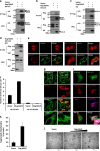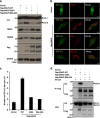MAVS maintains mitochondrial homeostasis via autophagy
- PMID: 27551434
- PMCID: PMC4986202
- DOI: 10.1038/celldisc.2016.24
MAVS maintains mitochondrial homeostasis via autophagy
Abstract
Mitochondrial antiviral signalling protein (MAVS) acts as a critical adaptor protein to transduce antiviral signalling by physically interacting with activated RIG-I and MDA5 receptors. MAVS executes its functions at the outer membrane of mitochondria to regulate downstream antiviral signalling, indicating that the mitochondria provides a functional platform for innate antiviral signalling transduction. However, little is known about whether and how MAVS-mediated antiviral signalling contributes to mitochondrial homeostasis. Here we show that the activation of MAVS is sufficient to induce autophagic signalling, which may mediate the turnover of the damaged mitochondria. Importantly, we find MAVS directly interacts with LC3 through its LC3-binding motif 'YxxI', suggesting that MAVS might act as an autophagy receptor to mediate mitochondrial turnover upon excessive activation of RLR signalling. Furthermore, we provide evidence that both MAVS self-aggregation and its interaction with TRAF2/6 proteins are important for MAVS-mediated mitochondrial turnover. Collectively, our findings suggest that MAVS acts as a potential receptor for mitochondria-associated autophagic signalling to maintain mitochondrial homeostasis.
Keywords: MAVS; autophagy; mitochondrial homeostasis.
Figures






Similar articles
-
Influenza M2 protein regulates MAVS-mediated signaling pathway through interacting with MAVS and increasing ROS production.Autophagy. 2019 Jul;15(7):1163-1181. doi: 10.1080/15548627.2019.1580089. Epub 2019 Feb 20. Autophagy. 2019. PMID: 30741586 Free PMC article.
-
COX5B regulates MAVS-mediated antiviral signaling through interaction with ATG5 and repressing ROS production.PLoS Pathog. 2012 Dec;8(12):e1003086. doi: 10.1371/journal.ppat.1003086. Epub 2012 Dec 20. PLoS Pathog. 2012. PMID: 23308066 Free PMC article.
-
Hepatitis C virus NS3-4A inhibits the peroxisomal MAVS-dependent antiviral signalling response.J Cell Mol Med. 2016 Apr;20(4):750-7. doi: 10.1111/jcmm.12801. Epub 2016 Feb 10. J Cell Mol Med. 2016. PMID: 26865163 Free PMC article.
-
Activation of RIG-I-Mediated Antiviral Signaling Triggers Autophagy Through the MAVS-TRAF6-Beclin-1 Signaling Axis.Front Immunol. 2018 Sep 12;9:2096. doi: 10.3389/fimmu.2018.02096. eCollection 2018. Front Immunol. 2018. PMID: 30258449 Free PMC article. Review.
-
Orchestrating the interferon antiviral response through the mitochondrial antiviral signaling (MAVS) adapter.Curr Opin Immunol. 2011 Oct;23(5):564-72. doi: 10.1016/j.coi.2011.08.001. Epub 2011 Aug 22. Curr Opin Immunol. 2011. PMID: 21865020 Review.
Cited by
-
Supramolecular Complexes in Cell Death and Inflammation and Their Regulation by Autophagy.Front Cell Dev Biol. 2019 May 3;7:73. doi: 10.3389/fcell.2019.00073. eCollection 2019. Front Cell Dev Biol. 2019. PMID: 31131275 Free PMC article. Review.
-
The MAVS and MAV-Nots: PINK1 Clears Prion-like MAVS Aggregates to Extinguish Mitochondrial Inflammatory Signaling.Am J Respir Cell Mol Biol. 2021 May;64(5):528-530. doi: 10.1165/rcmb.2021-0055ED. Am J Respir Cell Mol Biol. 2021. PMID: 33689599 Free PMC article. No abstract available.
-
Knockdown of TRAF6 inhibits chondrocytes apoptosis and inflammation by suppressing the NF-κB pathway in lumbar facet joint osteoarthritis.Mol Cell Biochem. 2021 Apr;476(4):1929-1938. doi: 10.1007/s11010-021-04048-x. Epub 2021 Jan 27. Mol Cell Biochem. 2021. PMID: 33502650
-
Mitophagy, Mitochondrial Homeostasis, and Cell Fate.Front Cell Dev Biol. 2020 Jun 24;8:467. doi: 10.3389/fcell.2020.00467. eCollection 2020. Front Cell Dev Biol. 2020. PMID: 32671064 Free PMC article. Review.
-
Mechanism and role of mitophagy in the development of severe infection.Cell Death Discov. 2024 Feb 19;10(1):88. doi: 10.1038/s41420-024-01844-4. Cell Death Discov. 2024. PMID: 38374038 Free PMC article. Review.
References
-
- Akira S, Uematsu S, Takeuchi O. Pathogen recognition and innate immunity. Cell 2006; 124: 783–801. - PubMed
-
- Yoneyama M, Kikuchi M, Natsukawa T et al. The RNA helicase RIG-I has an essential function in double-stranded RNA-induced innate antiviral responses. Nat Immunol 2004; 5: 730–737. - PubMed
-
- Seth RB, Sun L, Ea CK, Chen ZJ. Identification and characterization of MAVS, a mitochondrial antiviral signaling protein that activates NF-kappaB and IRF 3. Cell 2005; 122: 669–682. - PubMed
-
- Kawai T, Takahashi K, Sato S et al. IPS-1, an adaptor triggering RIG-I- and Mda5-mediated type I interferon induction. Nat Immunol 2005; 6: 981–988. - PubMed
LinkOut - more resources
Full Text Sources
Other Literature Sources
Miscellaneous

